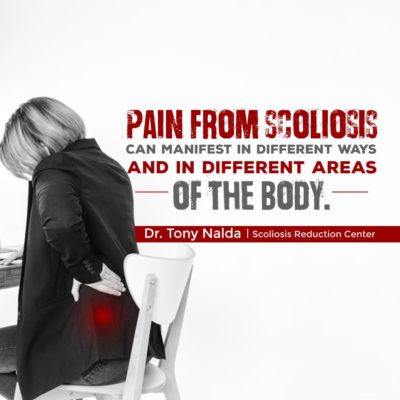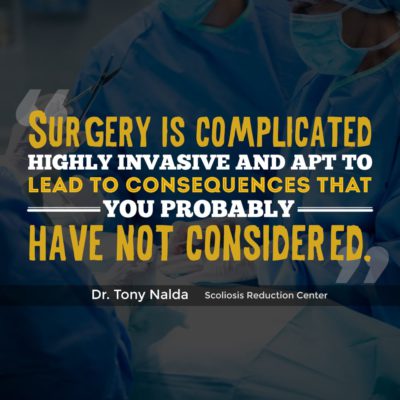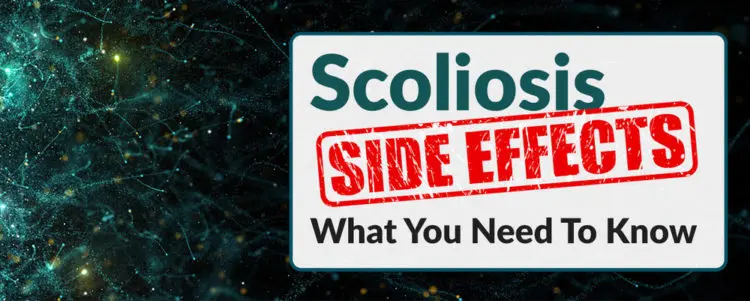If you are exploring treatment options for any kind of medical condition, it’s natural to be concerned about the associated side effects. And if you or your child requires treatment for scoliosis, you may be wondering if the effects of treatment are worth the relief that may be experienced.
The traditional scoliosis treatment approach typically leads to expensive and invasive surgery, so it’s completely reasonable for you to be concerned. However, you should also know that the traditional approach is not the only method of treatment that’s available.
The chiropractic-centered approach to scoliosis treatment offers an alternative that I believe is far superior to the traditional approach. It is possible to reduce curvatures and improve function without going under the knife. But you should understand that side effects are involved regardless of the approach you take to treatment.
Before you make any treatment decisions, I want to share some facts about scoliosis side effects, whether you are considering the traditional, surgical approach or not.
Let’s get started!
4 Key Takeaways
- Consequences of Untreated Scoliosis: Not addressing scoliosis can lead to a range of negative physical and emotional effects, including pain, posture issues, digestion problems, and emotional distress. Scoliosis impacts more than just spinal alignment; it can affect overall health, quality of life, and life expectancy.
- Surgical Treatment Side Effects: While surgery may seem like a definitive solution, it carries significant risks, including reduced flexibility, the need for further surgeries, infection, and possible neurological damage. These potential complications highlight the importance of carefully considering all treatment options.
- Bracing Treatment Drawbacks: Traditional scoliosis bracing can prevent condition progression but comes with its own set of challenges, such as emotional and psychological strain, physical discomfort, and social implications, affecting the patient’s self-esteem and social interactions.
- Advantages of Chiropractic-Centered Treatment: A chiropractic-centered approach offers an alternative to surgery and traditional bracing by focusing on reducing curvature and improving function with minimal side effects. This proactive and multifaceted treatment requires commitment but can lead to improved outcomes without the invasiveness of surgery or the constraints of traditional bracing.
The Side Effects of Scoliosis Itself
Before I get into the various side effects associated with different types of scoliosis treatment, I think it’s a good idea to cover some of the consequences of doing nothing.
Scoliosis is an abnormal curvature of the spine, but it’s also much more than that. The abnormal curvature affects the body and mind in a number of ways that you may not have considered.

In many cases, scoliosis does not lead to physical pain. But the longer a patient lives with the condition, the more likely it is that they will begin to experience pain.
Pain from scoliosis can manifest in several different ways, and in several different areas of the body. Left untreated, scoliosis side effects can include:
- Headaches
- Radicular (nerve) pain
- Neck pain
- Back pain
- Hip pain
- Knee pain
- Leg pain
For the most part, scoliosis pain is experienced mainly by adult patients. However, roughly 20 percent of adolescents with the condition also experience muscle pain to some degree. And it only gets worse over time.
The Social and Emotional Components of Life with Scoliosis
Some of the more troubling scoliosis side effects are not physical in nature. Instead, they manifest in a patient’s social and emotional lives.
The abnormal curvature of the spine can create physical limitations that lead to social difficulties, especially for adolescents who may not be able to participate in certain activities with their peers.
Scoliosis can also affect sleep negatively, which leads to lower energy levels, irritability and decreased performance in school or at work.
Maintaining a positive, optimistic view of life becomes more difficult when a person must deal with these side effects. Emotionally, people with scoliosis often must deal with anxiety or depression, which can be just as — if not more — debilitating than the physical side effects.
Other Scoliosis Side Effects
Leaving scoliosis untreated can lead to some other negative side effects:
- Digestion issues
- Negative impact on posture
- Issues with balance and equilibrium
- An association with low bone density
- Impacts on organ function (particularly in more severe cases)
- Reduced oxygen intake
- An average 14-year reduction in life expectancy
As you can see, scoliosis side effects can impact a patient in a variety of different ways. Certainly, treating scoliosis also comes with side effects, but the cost of doing nothing is too high to seriously consider such a passive approach.
The Side Effects of Scoliosis Surgery
Surgery is seen by many as the logical solution to the condition, and many patients go into surgery without an understanding of the impact it can have. In most surgeries for scoliosis, spinal discs are replaced with bone chips from the hip. Hooks, rods and screws are also inserted into the body in order to keep the spine in place while it fuses. This is not a simple procedure, and the potential for experiencing negative side effects is high.
Some of the side effects of scoliosis surgery include:
- Decreased flexibility and range of motion
- Potential for further surgery if the spine fails to fuse properly
- Wound infection
- Potential for severe neurological deficits

If you are worried about these side effects, I can’t blame you. Of course, surgeons do their very best to ensure positive outcomes for their patients, and the mortality rate for scoliosis surgery is very low. But surgery is complicated, highly invasive and apt to lead to consequences that you probably have not considered.
The Side Effects of Scoliosis Bracing
Prior to surgery, the traditional approach to treatment usually involves the prescription of a scoliosis brace, such as the Boston Brace or Milwaukee Brace. These devices must be worn for at least 16 hours a day in most cases, but they can be effective in terms of their ability to prevent scoliosis from getting worse. That being said, there are a number of associated physical, emotional and psychological side effects that stem from being confined to such a brace for long periods of time:
- Depressed mood
- Physical limitations that can reduce one’s overall quality of life
- Increased stress
- A decrease in self esteem
- Decreased flexibility
- Social isolation and anxiety
- Negative body image
- Pain and sores from the pressure the brace exerts on the body
While scoliosis bracing has been shown to help prevent the progression of the condition, it comes with consequences that patients and parents may not be willing to endure.
The Side Effects of Chiropractic-Centered Scoliosis Treatment
The type of treatment we provide here at the Scoliosis Reduction Center® is chiropractic centered. We don’t take patients down a path that leads to surgery, and our scoliosis bracing technology works in a manner that does not lead to the side effects listed above. With this approach, patients can reduce their curvatures and improve flexibility and function. And the side effects are minimal.
Patients who come to us for treatment should be prepared to put forth an effort that can leave them feeling exhausted, but in a manner that’s more like the feeling of a tough workout regimen. The treatment is multi faceted and intense, but our results speak for themselves!
If you’re interested in learning more about scoliosis side effects and the treatment options available with us, we’d love to hear from you! Give us a call today at 321-939-2328 to learn more.





